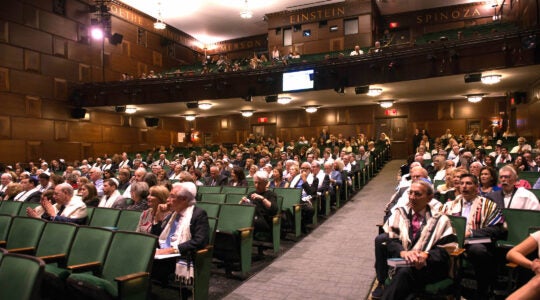‘The Talmud,” the cultural mash-up of a play by Jesse Freedman, is not a play in the orthodox sense, so to speak, but an artistic rendering of the text of Gittin 55-57, a Talmudic passage about divorce. In the 75-minute show (running through Sept. 28 at The Doxsee in Brooklyn), different actors read aloud three pages of the tractate, which in its expansive way includes an argument about land ownership, the famous story of the epic party invitation mistake of Kamza and bar Kamza, the famine caused by the siege of Jerusalem, the destruction of the Temple and the rise and fall of Titus.
In some scenes of “The Talmud,” there is Kung Fu-like sparring to represent the back and forth between scholars, or amoraim, found in the Gittin text. At times, the actors actually perform the story, such as the eventual death of the rich Marta bat Baitos or the downfall of Titus, who died from a bird burrowing into his brain and only found solace while being near the noise of a blacksmith.
Throughout the play, the actors’ lines mostly come straight from the Talmud, with little or no changes. The Kung-Fu fighting (though there isn’t much of it) is enough to display how the ancient rabbis parsed interpretations and argued about them at every step of the way. In some scenes, the actors walk in circles or figure-eights as they play different disputations in the text. The action beautifully captures the permutations and intellectual gymnastics found in the Talmud, with beautiful and haunting pipa (Chinese lute) music accompanying much of the performance.
The actual Talmud is an intellectual black box that represents a winding, complex way of thinking. The discussions are never linear, and there is never a consensus on how to study or interpret the text. It’s a hodgepodge. If we are The People of the Book, the book is a complicated one, and the play conveys this by hewing closely to the text.
In one scene, a partner pushes away his opponent, a sign that he just lost the argument. For anyone who has first-hand experience in this style of partner study, the subtle symbolism comes through. When partners argue, they are waging hermeneutical holy wars over what the Torah means with that one phrase or word they’re studying. The actors dramatize this kind of scholarly argument by sparring and running circles around one another while ducking and trying to hit back with a truer idea.
The few pages of the tractate Gittin are studied annually on the saddest day of the Jewish calendar, Tisha b’Av. We retell these stories because we hold our history — both the victories and the losses — close to our hearts. Like Talmud, Jewish history, however ancient, is ageless. It is kept in our back pocket and is a living thing. We retell the story of the Exodus on Passover and feel the destruction of the Temple during the Three Weeks. It’s why we see Spain through the lens of the Inquisition. It’s why I visited the Arch of Titus in Rome before Tisha b’Av — to see the physical manifestation of the ransacking and theft of our holy objects.
In one scene in “The Talmud,” when talking about Rabbi Yochanan Ben Zakai hiding in a box and acting dead to gain access to the soon-to-be king, a character quotes the Talmud and says, “A living person is lighter than a dead one.”
That is a metaphor for how we treat history. It’s alive and moving, light. Hiding in a box, but never really out of sight. The same way a piece of commentary of a weekly parsha reading is now an added line in the infinitely long scroll of the Oral Torah, a Kung-Fu interpretation is the next line in that story. It’s part of the living organism that makes up the framework of who we are as a people, all the while reimagining and reinterpreting what that story looks like. “The Talmud” fits perfectly — if unconventionally for a stage play — into our historical and innovative tradition.
More information on showtimes and tickets here.
The New York Jewish Week brings you the stories behind the headlines, keeping you connected to Jewish life in New York. Help sustain the reporting you trust by donating today.




